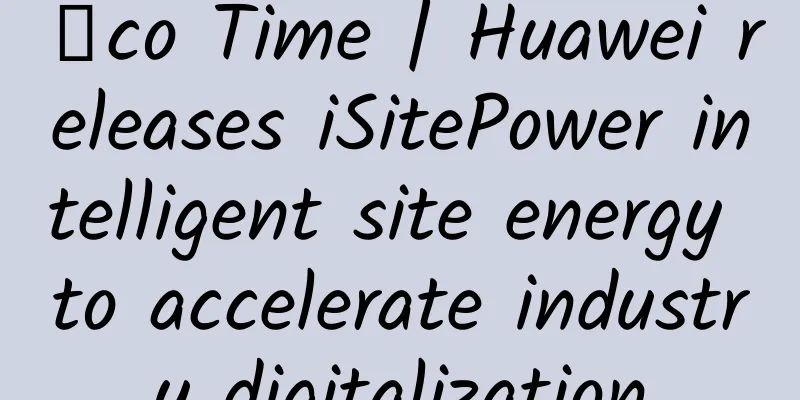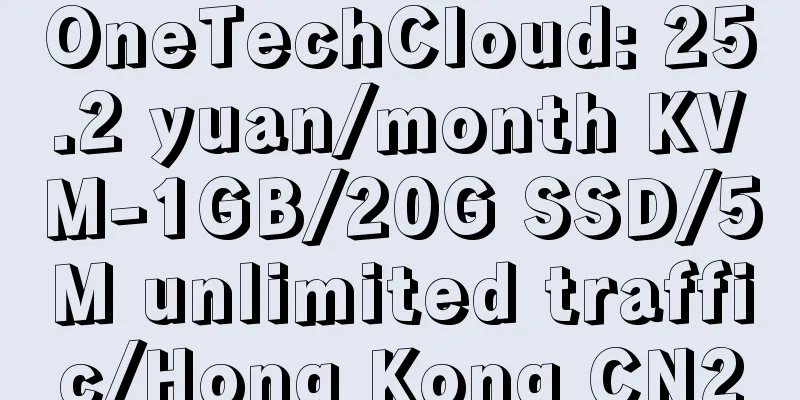Σco Time | Huawei releases iSitePower intelligent site energy to accelerate industry digitalization

|
[51CTO.com original article] Since the outbreak of the COVID-19 pandemic, Huawei has launched a series of #Σco时间# columns, which discuss technological change and industry transformation in the form of online live broadcast + interaction. At 3 pm on March 30, Huawei's iSitePower series solution launch conference was held on the #Σco时间# live broadcast platform. Wang Weiyi, director of Huawei's industry site energy products, was also invited to the #Σco时间# live broadcast room to discuss with thousands of online netizens how to accelerate the industry's digitalization process. The digital transformation of the industry has entered the "deep water zone", and infrastructure deployment faces challenges Wang Weiyi said that emerging technologies such as 5G and edge computing are now being integrated into thousands of industries, stimulating unlimited possibilities for digital transformation: On the one hand, 5G has started commercialization, and its low latency, large bandwidth, and high transmission characteristics have accelerated the arrival of the era of the Internet of Everything; on the other hand, computing power has begun to move from data centers to terminal sites, making computing ubiquitous. "Ubiquitous connectivity and computing have stimulated business changes and are giving rise to a large number of digital industry sites." He shared with netizens the three major trends in industry digital transformation that Huawei has observed. Trend 1: Wide-area coverage calls for diversified and flexible deployment of smart sites. For example, indoor deployments such as power transmission rooms and earthquake detection stations are mainly based on existing rooms, requiring high equipment density and easy stacking; while new outdoor equipment such as free-flow toll stations on highways and forest fire detection stations are mostly based on counters, requiring the system to occupy a small area and be easy to construct. Trend 2: The integration of multiple services at the same site requires strong compatibility and high reliability of the site infrastructure. Taking the highway industry as an example, the types of services undertaken by the roadside are gradually increasing, such as highway toll collection, high-speed overload control, road network perception, vehicle-road collaboration and other more business functions and equipment are sinking to the terminal site. Trend 3: More and more unattended and autonomous devices are being developed, calling for maintenance-free and intelligent operation and maintenance of site equipment. This is also a consensus in the industry, because many sites, such as high-altitude operations and deep forests and mountainous areas, are difficult to inspect, so the demand for cameras, power supplies, batteries and other equipment is to be more intelligent and reduce daily maintenance. "From these trends, we can clearly see that the construction of traditional energy infrastructure faces huge challenges. For example, the difficulty in finding sites and high costs in building sites, the poor reliability of power supply systems, and the low efficiency of operation and maintenance due to reliance on manual labor are all challenges that are difficult to meet the digital needs of the industry." Wang Weiyi pointed out that the industry urgently needs a power supply and backup infrastructure that is extremely simple, flexible, safe, reliable, and intelligently managed. "This is exactly the value of Huawei iSitePower Intelligent Site Energy." Huawei iSitePower Intelligent Site Energy: Multi-mode Empowering More Industry Scenarios
According to Wang Weiyi, Huawei iSitePower intelligent site energy has multiple forms of intelligent site energy, aiming to build the foundation of industry digitalization. For example, indoor integrated power supplies in the form of rooms are widely used in smart parks and safe cities, outdoor integrated power supplies in the form of cabinets are more often seen in seismic stations, forest fire prevention, and oil and gas pipeline monitoring, and integrated pole stations in the form of poles are used in scenarios such as smart highways and meteorological monitoring. He said that Huawei iSitePower indoor integrated power supply is equipped with high-density power batteries, one cabinet space replaces multiple cabinets, and AC/DC multi-standard integration is safer and more reliable. Intelligent lithium battery backup has a longer service life. In outdoor environments, due to the complex and harsher environment, Huawei iSitePower outdoor integrated power supply has achieved one station and one cabinet without a machine room, and the equipment is dustproof, waterproof and lightning-proof, bringing higher reliability to users. It is also equipped with intelligent management, full status visualization, and multiple intelligent anti-theft functions, which are safe and reliable. Huawei's small and lightweight integrated pole station provides users with minimalist coverage of the last mile, and easily achieves "no land occupation, one pole to solve power supply & backhaul" through integrated sensing poles. Helping all industries achieve digital transformation How does Huawei iSitePower intelligent site energy help the digital transformation of thousands of industries? Wang Weiyi also shared the application of Huawei iSitePower in different industries in the live broadcast room. In the government sector, a typical user has a load of 500W~1500W, complex equipment, coexistence of AC and DC loads, and a backup power time of only 10 minutes. The original UPS+power adapter+lead-acid configuration requires a short-term replacement of lead-acid batteries, which is replaced every six months, with high maintenance costs and no monitoring. After using Huawei's iSitePower smart site energy solution, AC and DC power supply and backup are all solved in one. At the same time, the high-density design of the power battery saves space, and the smart lithium battery has a long-term and reliable backup power time of up to 4 hours, and remote management is free of operation and maintenance. In the field of smart transportation, traditional manual toll collection methods are inefficient and can easily lead to traffic jams. After deploying Huawei iSitePower outdoor smart site energy, there is no need to deploy a machine room, the lithium battery backup power is 0 interruption, and Huawei products can work stably at -40℃~55℃, are dustproof and waterproof, and the toll collection business becomes more efficient, and the congestion of vehicles on and off the highway is greatly alleviated. In the field of forest fire prevention, Huawei iSitePower solar pole stations and cabinet stations can ensure reliable monitoring of forest fire prevention in all aspects. In comprehensive detection stations, Huawei has built integrated power supply and network, multi-standard output, and can also access environmental infection and other equipment. At high-point monitoring stations, Huawei uses solar access, and low-temperature lithium batteries solve the industry's pain points of low-temperature pure light backup power. At checkpoint monitoring stations, Huawei implements remote reset and restart, reducing the difficulty of operation and maintenance and improving operation and maintenance efficiency. In addition to the above fields, Huawei iSitePower smart site energy has also been widely used in water quality monitoring, smart distribution rooms, digital oil and gas and other fields. Huawei Energy has always been with customers and partners, leading the industry to continue to innovate. The live broadcast room also specially connected with Huawei's partner Capri. Capri's staff introduced that based on the support of Huawei's stable power supply, customers can collect a lot of data on outdoor pole station sensors. Wang Weiyi revealed that as of now, Huawei Energy has served more than 170 countries, more than 340 operators and more than 500 companies around the world. In the future, Huawei Energy will continue to lead the digitalization of energy and build a green and intelligent world. [51CTO original article, please indicate the original author and source as 51CTO.com when reprinting on partner sites] |
<<: 5 Service Level Agreement Best Practices for a Unified Communications Strategy
>>: Learn how to use IPv6 to surf the Internet in five minutes
Recommend
A super simple TCP communication package in C#: step by step guide
Hey, fellow developers! Today we are going to tal...
RAKsmart: US CN2 line VPS monthly payment starts from $0.99, Japan/Hong Kong VPS monthly payment starts from $2.99
The day before yesterday, we shared the news of R...
5G is officially commercialized in seven countries. Review of network events in the first half of 2019
On June 6, 2019, my country's 5G license was ...
The concept and installation plan of network bridge and wireless bridge
What is a bridge A bridge is like a smart repeate...
What changes will the integration of 5G and the Internet of Things bring?
The convergence of 5G and the Internet of Things ...
SmartHost: VPS 40% off, starting from $1.7/month, 29 computer rooms, optional AMD Ryzen+NVMe, optional large hard disk
SmartHost has just launched a Memorial Day 40% OF...
Another global battle for 5G has begun! What should China do?
At present, in addition to 5G, another global com...
The US 5G goal is "cold"! No one expected that the "ban" would slap itself in the face
Last year, the iPhone 12 was launched. The most o...
Kai-Fu Lee: Under what conditions will artificial intelligence surpass humans?
[51CTO.com original article] In recent years, art...
Will SD-WAN replace SASE? Intelligent network services still depend on its
If we think about it, we will find that many of o...
Web3.0 Technology: Unlocking the Future of the Internet
The Internet, the dynamic force that has reshaped...
RackNerd: Memorial Day Special Package $22.89/year - Dual Core/2G Memory/30G SSD/4TB Monthly Data Transfer
RackNerd has launched a special package for Memor...
Lenovo Debuts at Microsoft IoT Conference, Driving Business Intelligence Innovation with Smart IoT Devices
On December 3, the highly anticipated 2019 Micros...
CDN shifts from price war to technology war, will video cloud rewrite the market landscape?
Just as the rise of e-commerce was premised on th...
Sharktech: 1Gbps unlimited traffic high-security server starting at $59/month, Los Angeles data center
I saw a friend looking for a 1Gbps unlimited traf...









